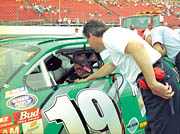

In the town of East Hartford, located just across the Connecticut River from the capital city of Hartford, Respect Innovations is taking giant steps in creating new coating technologies and applications that could change the way the automotive industry thinks about the raw material that goes into formulations for cars, trucks, sport-utility vehicles, and minivans.
Company literature explains that Respect Innovations was formed to “commercialize a new class of color achievement processes and enhancing additives.”
In February 2000, Respect Innovations developed Spek-Trum PCSTM (particle color systems), a coatings technology that the company says is so advanced it can “achieve full spectrum color on a variety of substrates without conventional pigments.”
The new technology, Respect also notes, is cost effective and includes such characteristics as daytime enhanced visibility and nighttime reflective and total darkness visibility (luminous).
In other words, Spek-Trum PCS is a revolutionary color, reflective, and luminescent particle system for automotive application that can’t be called paint, because, as Andrew Spencer points out, “Paint is normally defined as a product which imparts color through the use of organic and/or inorganic pigment. This is an entirely different process. It’s a non-pigmented color coating.”
As Respect Innovations puts it: “PCS breakthrough has brought the future to today.”
Witnessing the brilliant, seemingly miraculous effects Spek-Trum PCS can bring to automotive coatings — a veritable rainbow of bright, prismatic glowing colors that can be applied to any vehicle type — it’s hard to call that claim hyperbole. Spencer notes that, once the coating is applied in original equipment manufacturer mode, it will last for the life of the car, add a more durable finish than standard pigmented coatings, and increase the optic presence of a vehicle at night.

How Does it Work?
If Spek-Trum PCS doesn’t produce color using pigment, what is the process and what makes it a unique advancement in color coating technology?Through micro and nanoparticalization of organic and inorganic materials, the company has been able to hold color and other special effects inert within a particle. By doing so, they capture a new level of optics of color special effects as well as reflectability and luminosity. Andrew Spencer notes that the Particle Color System is proprietary, and while he is prevented from revealing too many details, he does explain that Respect Innovations began working on what he calls “the next range of technologies” by forming Micro Particle Technologies (MPT).
Through MPT, Respect Innovations deals with the integration of particle technology into existing products, using research and development services, and machinery design and development. The technique used under MPT provides improved characteristics that have never been seen and previously did not exist.
The benefits of MPT technology, the company reports, “are visually evident” in the products. The process gives a product, such as an automobile, enhanced appearance and improved physical properties. “The use of MPT in color advancement is prominent. In each case, brightness, reflectivity, durability, and true color are greatly enhanced.”
MPT has been involved with a dozen large companies in various forms of manufacturing to expand the use of particle mixes. The automotive industry is high on the list of many applications for the technology.
The characteristics that MPT can achieve include no color fading, enhancement of the product’s aesthetics, an unlimited color range, enhanced visibility, enhanced reflectivity, excellent insulation and cost-effectiveness. “We invented machinery and the process to take organic and inorganic materials, no matter what they are, and bring them into defined particle sizes and shapes that have never before been achieved,” Spencer explains. “There are literally thousands of materials that we use.” The process, he continues, delves into micro and nano particle ranges, which the group at Respect has had experience in developing. Through trial-and-error experiments with various materials, they achieved the effects they envisioned for colored coatings without the incorporation of pigments.
“The backbone of the process is getting the machinery and technology to generate new types of particles that do certain things,” Spencer says “It’s not like one particle is the miracle particle for us. Every particle has its definition.”
Through MPT, Spencer and company figured out, “We could get into the micro and nano particle range and how to micro- and nano-particalize minerals and materials, through powderization, fragmentation, and sphericalization. We developed a proprietary technology that can bring organic and inorganic materials to a level that can be used for things that they’ve never been adapted for previously.”
Under the MPT aegis, the micro-nano particle blends are:
- The smallest (much less than 0.1-40 micron) powderized particle blends manufactured in commercial volume.
- The smallest (much less than 0.1-40 micron) fragmented organic and non-organic materials.
- Creating spherical and polished micro-nano elements and materials.
Through this unique machinery, MPT can utilize mining operations and sites to be the source of a new color palette. “By using the excess material, we are actually cleaning up a site environmentally,” Spencer says. This provides an alternate color source. The application possibilities are endless with this process.
“The machinery that we’ve invented is even different in the sense that it’s a process that is a dry method, not water wash, which is a really revolutionary concept.” Spencer stresses that what Respect Innovations is doing “is not evolution; it’s a revolution, because evolution is, ‘Let’s make a pigment better.’ This is a revolution because we don’t need pigment.”
As Spencer explains the process, MPT reflects a unique method of achieving and holding color within a carrying system that wouldn’t fade or bleed, that would have flow characteristics unknown to anyone, and “we figured out how to do it without pigment.
“We figured out that we could hold color inert in a particle,” he continues. “With a multitude of different micro-particle blends, we can achieve color and we can achieve different effects.”
Those particle arrangements led to the development of Spek-Trum ACT (Advanced Coating Technologies). Spek-Trum ACT takes the particles and formulates them into finished systems for automotive, marine, textile and other industrial uses.
“We can manufacture and duplicate this process in all colors for the future,” Spencer says. The process’s effects can be used in all existing coatings systems and applications. And, because the technology is particle- rather than pigment-based, it is more economical.
With its innovative technology, Respect is capable of creating nearly infinite satellite companies and research/development entities for myriad applications. Spencer reiterates that safety is an important facet of the products Respect Innovations develops: “It’s a safety reflective technology.”
Among Respect’s many spin-off companies and applications is Flame-Tek, a company specializing in protective coatings technology. Flame-Tek is ready to launch up to 72 separate products featuring flame-retarding properties.
One of Flame-Tek’s goals is to raise safety awareness and standards “through a strong presence in the marketplace with a full line of fire retardant products and services.”
“Through the course of business, our philosophy at Respect is to do three things: joint ventures, partnerships, and strategic alliances with companies,” Spencer says.
Adherence to these three business principles has led them to form alliances with mining operations, paint manufacturers, and some of the nation’s top corporations.
Respect is currently working with Fortune 500 companies to integrate its technologies. Some of the particle systems the company has created encompass dry particle mixes for inks, dyes, coatings, and anodizing; powder coatings for automobiles; clear topcoat systems; and applications for the marine and apparel industries.
In terms of automotive coating technology, Spek-Trum ACT has created Spek-Trum Finishes, a stand-alone paint company for the automotive finish industry. They have formed an alliance with a privately owned paint company in North America for its automobile coating application, Andrew Spencer says.
“We’re ready to go and have a full line of products in mind,” he says. “We’re going to be networking through national distributors to get the finishes on the market and to build a solid brand name for Spek-Trum Particle Color Systems.” Respect also has created an entity called Spek-Trum Aerosol Technologies, “to answer the needs for aerosol refinishing.”
To introduce its technology and commitment to safety, Respect Innovations formed Motorsports Safety Technologies (MST), which is essentially the same core group who invented the Spek-Trum series.
“The idea of MST is to utilize it as a tool to get out the information to corporate America and consumers through auto racing,” Spencer says.
This was accomplished in 1999, when the MST logos and coatings were featured on a car racing in NASCAR’s Winston Cup race. This year, an MST car driven by NASCAR Racer Mike Bliss was featured in the Busch series at Daytona.
The NASCAR involvement was designed “to generate safety through our technology,” Spencer says. The cars highlighted the Spek-Trum attributes of high color reflectivity and flame retardant qualities.
“The reason we did this was to benchmark safety on the track with Ford, Chrysler and General Motors, through innovative technologies in coatings,” Spencer explains.
For the average driver, the benefit of Spek-Trum’s reflective coatings is the technology’s ability to produce spectacular color effects when the coating is hit by light, Spencer says. The coating can hold light up to seven hours or more when headlights hit it at night.
Sidebar: Respect Innovations: A Revolution in Coating Technology
Respect Innovations’ top players include Andrew Spencer, chairman and chief executive officer; his brother, Craig Spencer, executive vice president; Scott Pierce, vice president of operations; Dan Zurmuhlen, vice president of research and development; Rick Gorden, vice president of graphic and color design; and Ed Brown, business manager.The company has offices in the Midwest, with partners Nick Cassiello and his sons Nick Jr. and Jeremy, along with Tracy D. Parrotte. Dave Morris and Steve Owens oversee the West Coast operations.
The five Connecticut visionaries who founded the company grew up together in the rural Eastern Connecticut community of Coventry. Andrew Spencer, the company’s founder, has been involved in reflective and light-emission enhancement for the past 15 years. He holds six patents in micro-prismatic sheeting, in combination with luminescence and electro luminescence. In 1994, he applied his patented processes to develop Glo-Flex, a night safety luminescence product.
For more information on Respect Innovations Inc., write 11 Village St. East Hartford, CT 06108; phone 860/289.3031; fax 860/289.3051; e-mail respectinnovations@yahoo.com;
An Inventor’s History
To understand how Respect Innovations came to be, it’s necessary to look back to the early experiments of Andrew Spencer, and to trace his development into what his colleagues call a “modern-day Einstein and self-studied entrepreneur.”Spencer says all of his inventions and ideas stem from the concept of “channeling of light, being able to see something in a couple of products and figuring out how to utilize the technology that existed and form it into new and existing technologies.
“I’ve always tried to do my own thing,” he says, and adds that he is self taught in the scientific process and works in the classic mode of trial and error.
In the early 1990s, at his house in Coventry, CT, Andrew Spencer and his brother, who worked as a machinist for 15 years, were working on what they call “micro-prism particle technology for textiles and luminescence.” Their experiments involved curing products in Andrew’s oven and trying out products on his front porch.
He says he always “worked instinctively” with channeling light and micro-prism sheeting. Andrew explains that there are 47,000 micro prisms per square inch on PVC-type material, such as plastics. “With 47,000 prisms per square inch, you can retro-reflect light into a source and direct it back at the light source,” he says. “So, we were trying to find out if we could get particles that could do the same thing. We were trying to take different elements from sheet forms and break them down into particles for the textile application.”
Luminescence was the brothers’ key concept. “Everything we did was always reflective and glow-in-the-dark,” Andrew says.
One of Andrew Spencer’s first successes in electro-luminescence — the integration of electrical luminescence and various carriers — was Glo-Flex, his first product and patent. The product was created to be applied to a pet’s collar and leash, so that it would glow in the dark for total visibility at night.
“Our philosophy of product development has always been around safety,” Spencer says.
In conjunction with their textile experiments, Craig and Andrew Spencer moved into trying to develop a micro-prismatic tape that they hoped would replace the 3M-type reflective products on the market.
“We were trying to incorporate reflective particles that were loose and mixed right into a carrier,” Craig says. Craig designed the machinery that would produce the reflective tape at a high speed. “From there we started designing machines for our new processes and materials so we could take particles and coat them to a desired effect, like applying color and metal to the particles.”
“There weren’t too many people out there doing this,” Andrew says. “We made our process adaptable to anything. We perfected knife-over roll, saturation coating, rotary and direct screen printing, flat bed screening, and transfers. These are adaptations to existing technologies that can be applied to anything. That’s the beauty of this technology.”
During those experiments, Craig and Andrew had what they call their “Eureka!” moment — a moment that ultimately led to the creation of Respect Innovations.
One night, Andrew was working on textile washes and coatings in his kitchen sink, which was lit by an overhead light. “When I rinsed out the inks that we had made for the textiles, I looked in the bottom of the sink and saw an arrangement of glass beads and particles,” Andrew says. “At that point we moved ahead.”
Craig adds that, after discovering the bead phenomenon in the sink, he and Andrew cut a piece out of a 1967 Chevrolet hood, sprayed it with the beaded paint product they developed from the bead discovery, and sent the piece to General Motors.
GM showed an interest in the strange object “because it worked,” Craig says. “Our achievement was utilizing a specific glass bead for achieving flow and different looks in pigmented paint systems.”
Using the new bead technology they had discovered, the Spencers, along with fellow inventors Gary Tucker and John Andrews, created a technology research company called ICU/Prizmalite in 1997. ICU/Prizmalite eventually became an independent company manufacturing patent-approved enhanced beaded paint for the auto industry. Andrew stressed the fact that ICU/Prizmalite was working within a pigmented paint system, which is very different from what Respect Innovations has done.
ICU/Prizmalite decided to go independent and be involved more on a daily basis with the auto industry, establishing offices in Manhattan and Detroit.
“We’re inventors,” Andrew says. “The core group here [at Respect Innovations] is always going to be inventive. I tried a couple of times to be an invention company, and every time I came up with a good concept, everything got lost in the first concept we came up with. We decided to move on after building Prizmalite to form Respect Innovations. Our ability is to diversify major companies to go places they’ve never gone before. We are pushing all of the major paint companies to look at things differently.”
In creating the new company, Andrew Spencer and his colleagues chose “Respect” as a main title concept because “We didn’t get respect for what we were doing,” which, he says, is a typical response to inventor/entrepreneurs from skeptics in and out of the businesses that would use their products.
“Inventors never really get too much respect,” Andrew says. “They’re always looked down on. When you’re poor, you’re a nut case. When you make something work, all of a sudden you’re an eccentric genius.” “More than once, we were considered dreamers,” Craig adds.
Each member of Respect Innovations has a specific skill that contributes to the total package put together by Andrew Spencer’s intuitive inventive genius.
Craig Spencer’s experience as a machinist and partner in experiments with his brother allowed him to design the machinery Respect would need to make their micro- and nano-particle technologies work in fact. Scott Pierce’s experience as a manager and top salesman in the automotive industry gave him solid marketing savvy to get Respect’s products known throughout the industries they were targeting. Rick Gorden’s talents as a graphic artist were important to developing particle arrangements and color design, and in designing promotional materials; Ed Brown’s business experience was valuable in keeping the office operations running properly.
And Dan Zurmuhlen’s long experience in the auto body business and as a teacher of auto paint and refinishing brought to the table a solid foundation in research and development of the coatings. He has contributed some “creative coloring” of his own as well.
“There isn’t anything in this world that I can’t apply and make it look better,” Zurmuhlen says. His research resulted in essential processes that can be multiplied by the 39,000 possible color combinations that Respect Innovations can produce. “This product has a different look, a different effect, a different illusion which creates an effect that everyone wants, and there’s not one person who has disliked anything I’ve done so far,” he says.
What the long trail of experimentation and serendipity has led to is, in its purest form, clearly a revolution in coating technology. Respect Innovations’ principals see no limits to where they can take their discoveries.
To prove that, Dan Zurmuhlen proudly shows off a photo of a car glowing with the basic colors of the prism, like some kind of outer space phenomenon. He designed the effect and Respect Innovations created it.
As Zurmuhlen observes: “No pigment, no problem.”


Report Abusive Comment